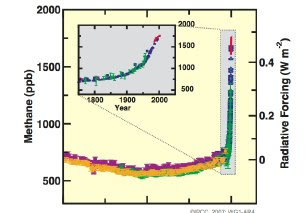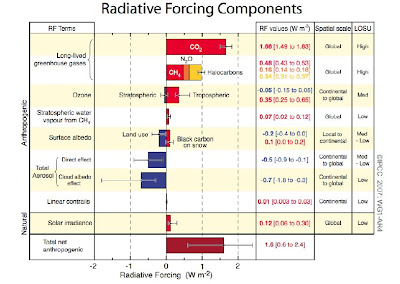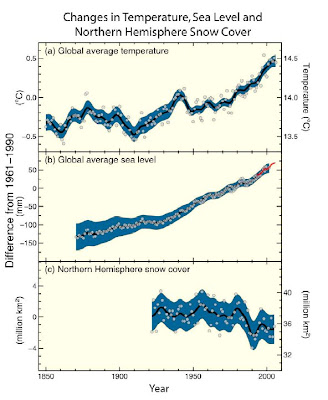Part 1: Energy Balance of the Earth and Greenhouse Gases
I have decided to break down the summary of the conclusions from the Intergovernmental Panel on Climate Change into two posts instead due to the amount of information contained in it. This is the same document that the Nuncio and the Holy See are referring back to when speaking of global warming, so it is important for us to understand what is contained in it.
Basically, I have used the same text in the document (in blue) by copying the main points for each topic and changing the layout or emphasizing certain figures to make it a bit easier to read. Definitions used in this report are included below. My side-comments are in red.
Part I: HUMAN AND NATURAL DRIVERS OF CLIMATE CHANGE
Changes in the atmospheric abundance of greenhouse gases and aerosols, in solar radiation and in land surface properties alter the energy balance of the climate system. These changes are expressed in terms of radiative forcing, which is used to compare how a range of human and natural factors drive warming or cooling influences on global climate.
CONCLUSION:
- Global atmospheric concentrations of carbon dioxide, methane and nitrous oxide have increased markedly as a result of human activities since 1750 and now far exceed pre-industrial values determined from ice cores spanning many thousands of years.
- The global increases in carbon dioxide concentration are due primarily to fossil fuel use and land-use change, while those of methane and nitrous oxide are primarily due to agriculture.
OBSERVATIONS
- Carbon dioxide is the most important anthropogenic [caused by humans] greenhouse gas. The global atmospheric concentration of carbon dioxide has increased from a pre-industrial value of about 280 ppm to 379 ppm [parts per million] in 2005.
- The atmospheric concentration of carbon dioxide in 2005 exceeds by far the natural range over the last 650,000 years (180 to 300 ppm) as determined from ice cores.
- The primary source of the increased atmospheric concentration of carbon dioxide since the pre-industrial period results from fossil fuel use, with land use change providing another significant but smaller contribution.
On Methane (CH4):
- The global atmospheric concentration of methane has increased from a pre-industrial value of about 715 ppb to 1732 ppb [parts
 per billion] in the early 1990s, and is 1774 ppb in 2005. The atmospheric concentration of methane in 2005 exceeds by far the natural range of the last 650,000 years (320 to 790 ppb) as determined from ice cores.
per billion] in the early 1990s, and is 1774 ppb in 2005. The atmospheric concentration of methane in 2005 exceeds by far the natural range of the last 650,000 years (320 to 790 ppb) as determined from ice cores. - Growth rates have declined since the early 1990s, consistent with total emissions (sum of anthropogenic and natural sources) being nearly constant during this period. It is very likely that the observed increase in methane concentration is due to anthropogenic activities, predominantly agriculture and fossil fuel use, but relative contributions from different source types are not well determined.

On Nitrous Oxide (NO2):
- The global atmospheric nitrous oxide concentration increased from a pre-industrial value of about 270 ppb to 319 ppb in 2005. The growth rate has been approximately constant since 1980. More than a third of all nitrous oxide emissions are anthropogenic and are primarily due to agriculture.
CONCLUSION:
- The understanding of anthropogenic warming and cooling influences on climate has improved since the Third Assessment Report (TAR) [previous assessment], leading to very high confidence that the globally averaged net effect of human activities since 1750 has been one of warming, with a radiative forcing of +1.6 W m-2.
- The combined radiative forcing due to increases in carbon dioxide, methane, and nitrous oxide is +2.30 W m-2, and its rate of increase during the industrial era is very likely to have been unprecedented in more than 10,000 years.
OBSERVATIONS
[The picture below can look rather intimidated, but you can look at first the left-hand side of the figure. Greenhouse gases and other agents are divided in natural and anthropogenic elements. The center of the figure that contains the bars indicate the radiative forcing for each element. In simple terms, if the radiative forcing is negative for a specific element, it tends to cool the surface of the earth, if it is positive, then the element tends to warm the surface. Note that CO2 has the highest radiative forcing; therefore, the highest contribution in heating the surface. The last bar shows the net anthropogenic radiative forcing, which excludes all other natural agents.]

Part II: DIRECT OBSERVATIONS OF RECENT CLIMATE CHANGE
CONCLUSIONS:
- Warming of the climate system is unequivocal, as is now evident from observations of increases in global average air and ocean temperatures, widespread melting of snow and ice, and rising global average sea level.
OBSERVATIONS
Global surface temperature:
- Eleven of the last twelve years (1995 -2006) rank among the 12 warmest years in the instrumental record of global surface temperature (since 1850).
Global Ocean temperatures and levels:
- Observations since 1961 show that the average temperature of the global ocean has increased to depths of at least 3000 m and that the ocean has been absorbing more than 80% of the heat added to the climate system. Such warming causes seawater to expand, contributing to sea level rise.
- Global average sea level rose at an average rate of 1.8 mm per year over 1961 to 2003. The rate was faster over 1993 to 2003, about 3.1 mm per year. Whether the faster rate for 1993 to 2003 reflects decadal variability or an increase in the longer-term trend is unclear. [In other words, it is hard to understand the relevance of the faster rate in which the sea levels rose from 1993-2003, because of the short-term period of observation. It is hard to understand whether this will be a continuing trend or just a result of high variability.]
Glaciers and sea levels:
- Mountain glaciers and snow cover have declined on average in both hemispheres. Widespread decreases in glaciers and ice caps have contributed to sea level rise.
- New data shows that losses from the ice sheets of Greenland and Antarctica have very likely contributed to sea level rise over 1993 to 2003.

Definitions:
Climate change in IPCC usage refers to any change in climate over time, whether due to natural variability or as a result of human activity.
Radiative Forcing is a measure of the influence that a factor has in altering the balance of incoming and outgoing energy in the Earth-atmosphere system and is an index of the importance of the factor as a potential climate change mechanism. Positive forcing tends to warm the surface while negative forcing tends to cool it.
Virtually certain > 99% probability of occurrence,
Extremely likely > 95%,
Very likely > 90%,
Likely > 66%,
More likely than not > 50%,

















